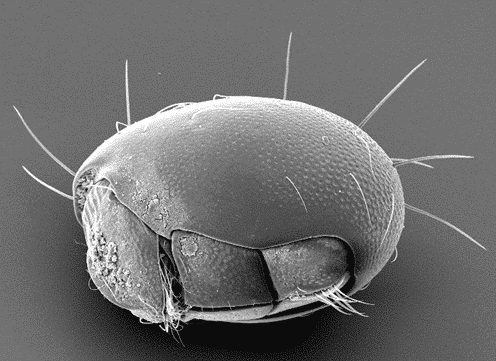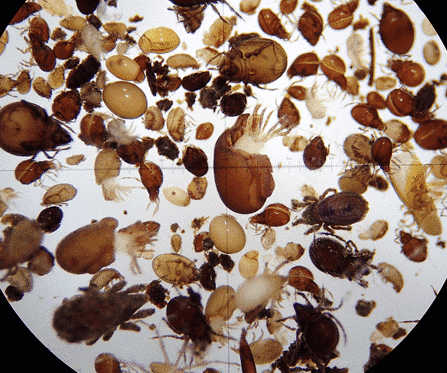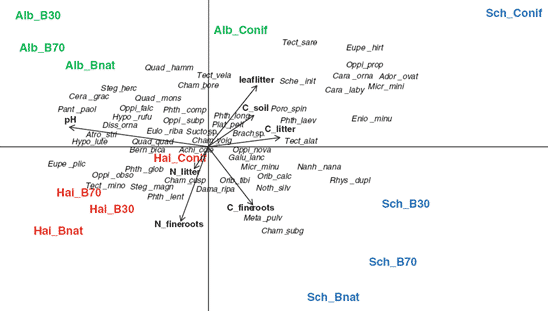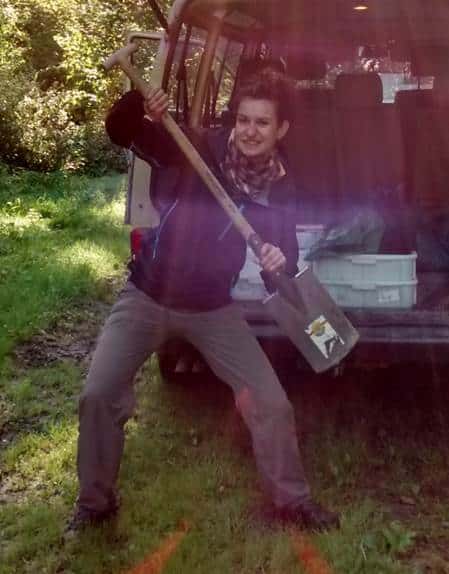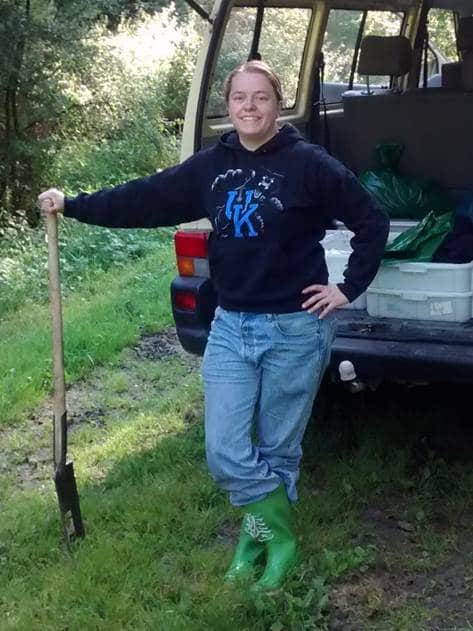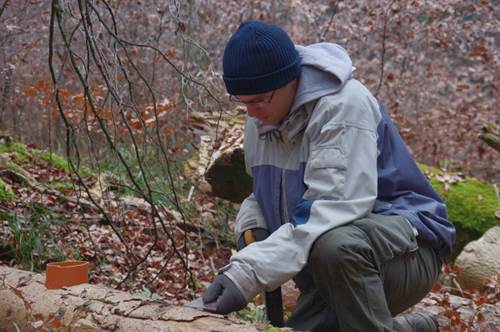Influence of land use, dispersal ability and deadwood on the feeding biology, community structure and reproductive mode of horned mites (Oribatida, Acari).
The population dynamics and trophic plasticity of horn mites (Oribatida) along land use gradients in forests have been insufficiently studied so far. In this project we investigate the following three topics:
1. temporal dynamics of soil-dwelling horn mite communities along a land-use gradient.
2. influence of land use on the feeding biology of horn mites by analysing neutral lipid patterns. This subproject will contribute to the understanding of trophic plasticity and niche breadth of horn mites.
3. influence of nutrient addition on horn mite communities of deadwood along a land use gradient (BeLongDead project). We cooperate with the project of Stefan Scheu (LitterLinks) and with the BeLongDead consortium (coordinated by Wolfgang Weisser).
Understanding the structure and function of soil animal communities is essential for understanding the function of the decomposer system “soil” as a whole. In recent years, horned mites (oribatids) have become one of the model taxa used to study soil community structure and function. Oribatids are a species-rich group with about 10,000 described species and densities of 20,000 – 400,000 m² in temperate forests. Despite immense progress in the fields of feeding biology (Maraun et al. 2011), reproductive biology (Maraun et al. 2012), dispersal ability and factors influencing oribatid community structure (Maraun et al. 2014), many questions about understanding the structure and function of soil animal communities remain poorly understood. In particular, the temporal dynamics of horned mite populations, the trophic niches that enable their high diversity in soil, and the high number of parthenogenetic species are least understood. The aim of this project is therefore to fill these gaps in our knowledge.
To this end, the following hypotheses are examined:
1. the density of parthenogenetic horned mite species fluctuates more in the annual cycle than that of sexual species, because the density of parthenogenetic species is regulated by density-independent factors (as these species are not subject to resource limitation; Scheu & Drossel 2007).
2. parthenogenetic oribatids occupy lower levels in food webs, i.e. are more likely to be primary decomposers and only rarely fungivores or predators. To this end, the nutritional biology of horn mites is studied using the method of fatty acid analysis (NLFAs).
3. increasing nutrient availability will shift the horn mite community of deadwood from sexual to parthenogenetic species. This experiment is being conducted as part of the BELongDead project of the Biodiversity Exploratories, as oribatids in this habitat largely reproduce sexually (90-95%; Erdmann et al. 2006; Fischer et al. 2010b).
Ehnes RB, Pollierer MM, Erdmann G, Klarner B, Eitzinger B, Digel C, Ott D, Maraun M, Scheu S, Brose U (2014) Lack of energetic equivalence in forest soil invertebrates. Ecology 95, 527-537
Maraun M, Augustin D, Müller J, Bässler C, Scheu S (2014) Changes in the community composition and trophic structure of microarthropods in sporocarps of the wood decaying fungus Fomitopsis pinicola along an altitudinal gradient. Applied Soil Ecology 84, 16-23
Wehner K, Scheu S, Maraun M (2014) Resource availability as driving factor of the reproductive mode in soil microarthropods (Acari, Oribatida). PLoS ONE 9: e104243
Heidemann K, Ruess L, Scheu S, Maraun M (2014) Nematode consumption by mite communities varies in different forest microhabitats as indicated by molecular gut content analysis. Experimental and Applied Acarology 64, 49-60
Klarner B, Maraun M, Scheu S (2013) Trophic diversity and niche partitioning in a species rich predator guild – natural variations in stable isotope ratios (13C/12C, 15N/14N) of mesostigmatid mites (Acari, Mesostigmata) from Central European beech forests. Soil Biology and Biochemistry 57, 323-333
Birkhofer K, Schöning I, Alt F, Herold N, Klarner B, Maraun M, Marhan S, Oelmann Y, Wubet T, Yurkov A, Begerow D, Berner D, Buscot F, Daniel R, Diekötter T, Ehner RB, Erdmann G, Fischer C, Foesel B, Groh J, Gutknecht J, Kandeler E, Lang C, Lohaus G, Meyer A, Nacke H, Näther A, Overmann J, Polle A, Pollierer MM, Scheu S, Schloter M, Schulze ED, Schulze W, Weinert J, Weisser WW, Wolters V, Schrumpf M (2012) General relationships between abiotic soil properties and soil biota across spatial scales and different land-use types. PLoS ONE 7(8), e43292
Maraun M, Norton RA, Ehnes R, Scheu S, Erdmann G (2012) Positive correlation of density and parthenogenetic reproduction in oribatid mites supports the “Structured Resource Theory of Sexual Reproduction”. Evolutionary Ecology Research 14, 311-323
Erdmann G, Scheu S, Maraun M (2012) Regional factors rather than forest type drive the community structure of soil living oribatid mites (Acari, Oribatida). Experimental and Applied Acarology 57, 157–169
Maraun M, Erdmann G, Fischer BM, Pollierer MM, Norton RA, Schneider K, Scheu S (2011) Stable isotopes revisited: their use and limits for oribatid mite trophic ecology. Soil Biology and Biochemistry 43, 877-882
